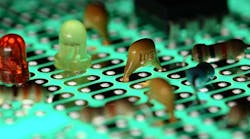How Custom Components Solve Design Challenges While Saving Time and Cost
This article is part of the System Design Series: From Design to Delivery: Creating Embedded System Solutions.
What you’ll learn:
- Options available to electronics designers and engineers looking for specific, custom components.
- Reasons why selecting custom components might be the right solution for electronics designers.
Electronic product designers can’t always find the components that fit their exact needs, nor do they have time to chase down sources for hard-to-find parts. Our previous article in this series explored how designers can benefit from custom kitting to eliminate the complexities of sourcing products. But the advantages of customized components extend beyond sourcing kits.
Maybe the designer has an obsolete component, a hard-to-find part, the wrong color, or is simply not quite sure what they want. Working with individual customized parts—from batteries to panel meters to cable assemblies—can accelerate the design process while shielding designers from the frustrations of sourcing rare products.
Capitalizing on Customization
Customization is often necessary for obsolete components. Many companies have legacy equipment that needs to be maintained, yet replacement components for obsolete and legacy systems are often hard to find.
A good electronics distributor partner has the expertise to re-engineer, build, and test these needed components to extend the useful life of legacy systems. For example, a designer may need a custom range for a legacy system’s voltage meter (e.g., 0 to 25 V) when only higher-voltage-range meters are available off the shelf.
Many designers may need customized components to fit brand requirements. They may need to change product attributes like colors, shapes, or logos to fit aesthetic and quality design requirements. Others might need customized components to meet performance requirements. They may require specific battery packs with a unique size and capacity to deliver on the product’s intended usage.
Customization also is a good path for designers who lack expertise to retool their systems and don’t want to invest in the tooling and training to meet their product requirements. For instance, a designer may need a unique case for the control of a new electronic guitar pedal. Lacking the right drill bits and other tools might result in a DIY nightmare where the holes are imprecise and out of alignment. Paying a distributor with the right supplier partners will often lead to better results, lower costs, and higher quality.
Less rework is another benefit of customization. Take cables, for example. A designer may need a cable harness but finds that the harness contains a number of unnecessary cables.
Customized harnesses mean the designer doesn’t have to invest in the unwanted cables, nor invest in the specialized tooling needed to attach connectors to the cables. The quality of the connection will inevitably be superior when done by an expert, and the designer will be assured that the cabling and connectors meet all necessary codes and certifications, such as UL.
Customization can make sourcing products in a turbulent market easier and more reliable as well. When designers’ products rely on custom components that they procure from a reliable distributor, they have better control over their inventory during times of market and supply-chain fluctuations. They will take solace in knowing the part’s availability, logistics, and lead times.
Common Customized Parts
What kind of components have the highest demand for customization? Building custom components for thousands of product designers has given us insight into which parts are most frequently customized. They include:
- Wire and cable assemblies: Particularly in terms of custom colors and lengths. Custom wire harnesses are popular, too, because it alleviates the need to invest in short runs of all the different wires that required.
- Panel meters: Typically customized with logos, colors, nonstandard ranges, and input signals.
- Connectors: On one hand, so many different types of connectors are available that customization may not seem necessary, but product designers often need to modify connectors to obtain variations best suited for their application.
- Re-reeling: Custom re-reeling for semiconductors and passive components are popular requests. Designers needn’t invest in full tape-and-reel components, saving on parts and eliminating leftover scrap strip waste.
- Enclosures: Designers can select the type of enclosure based on the application need, whether it be metal, fiberglass, steel, NEMA polycarbonate, ABS, or die-cast cases. Customization also allows for unique colors and finishes. Some designers need custom-drilled holes or cutouts made, or special packaging, handles, hinges, EMI/RFI shielding, or non-standard racks and shelves.
- Switches: Designers often want switches modified with options such as custom legends, printed with colors and custom decals.
Customization services can be a significant time- and cost-saver for busy designers who may need to replace obsolete components, better match design specs, source new rare components, or change product attributes, among many other modifications. Working with an experienced distributor, like Newark, can ensure customized components work as promised and meet all performance and safety requirements.
Read more articles in the System Design Series: From Design to Delivery: Creating Embedded System Solutions.

